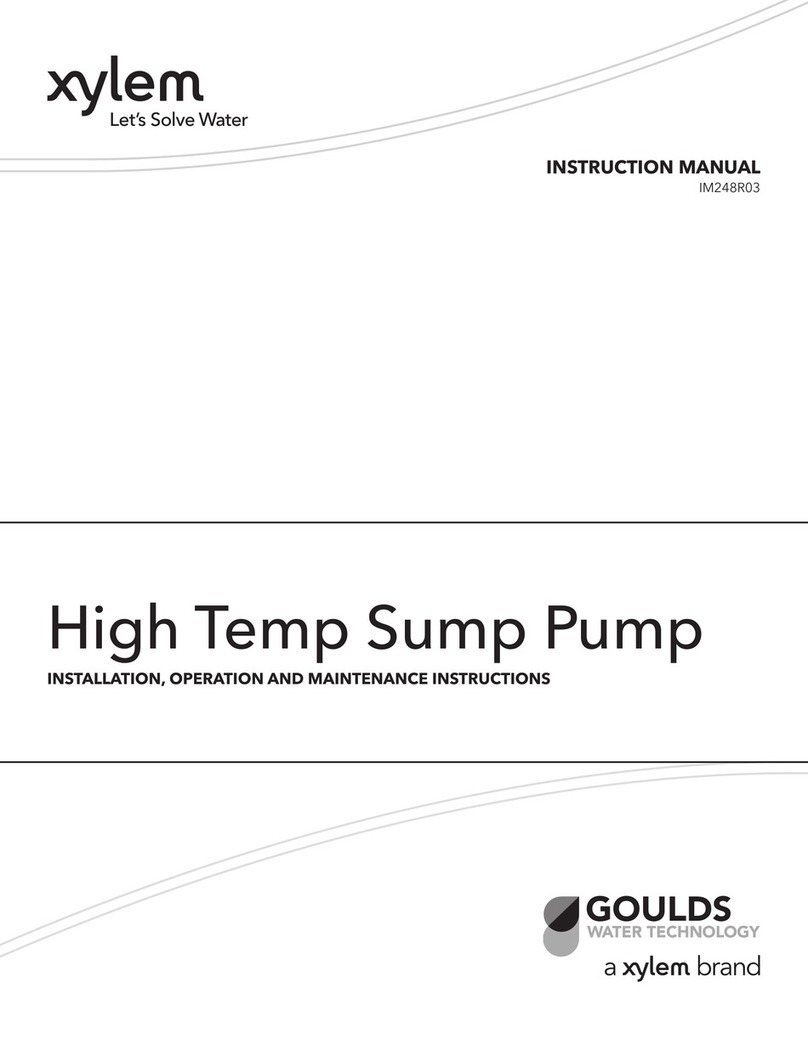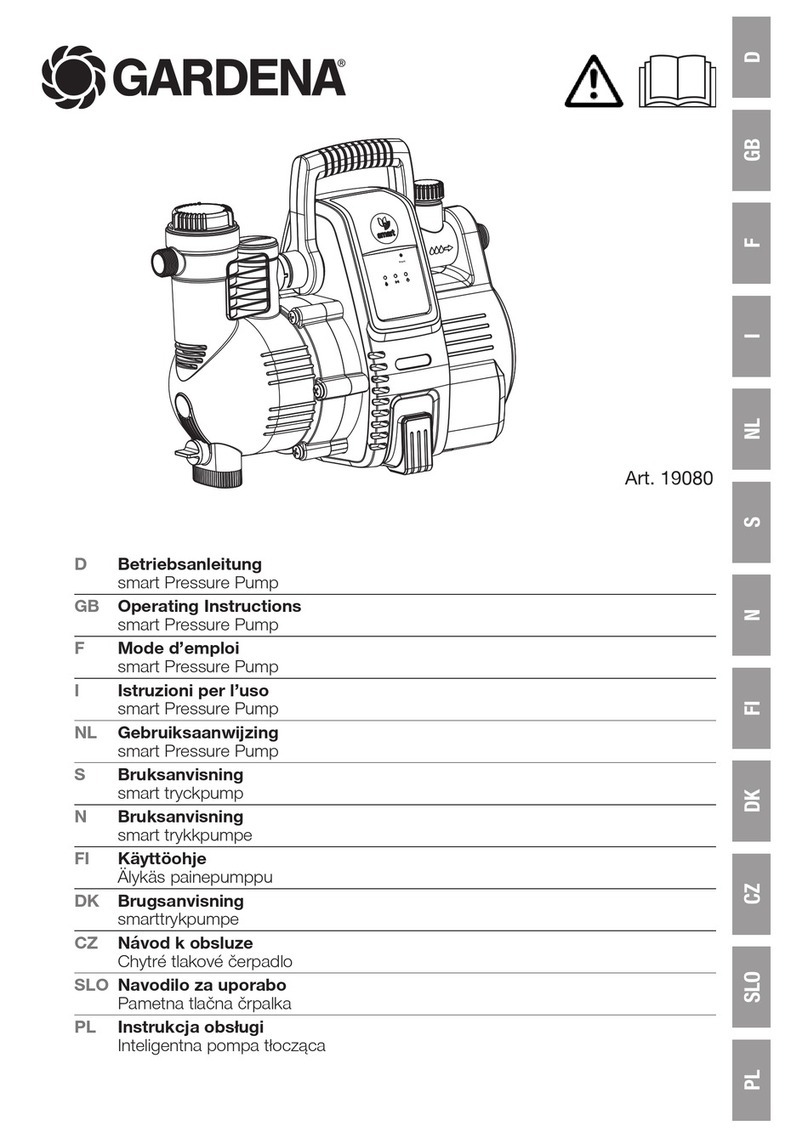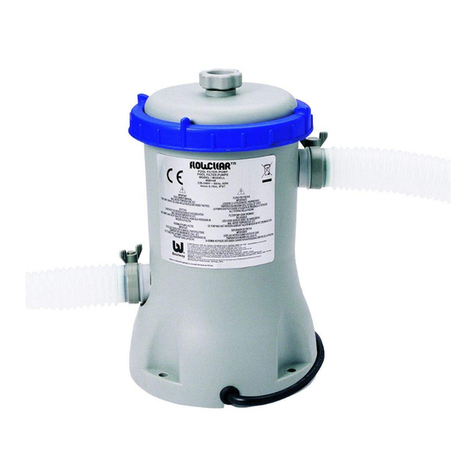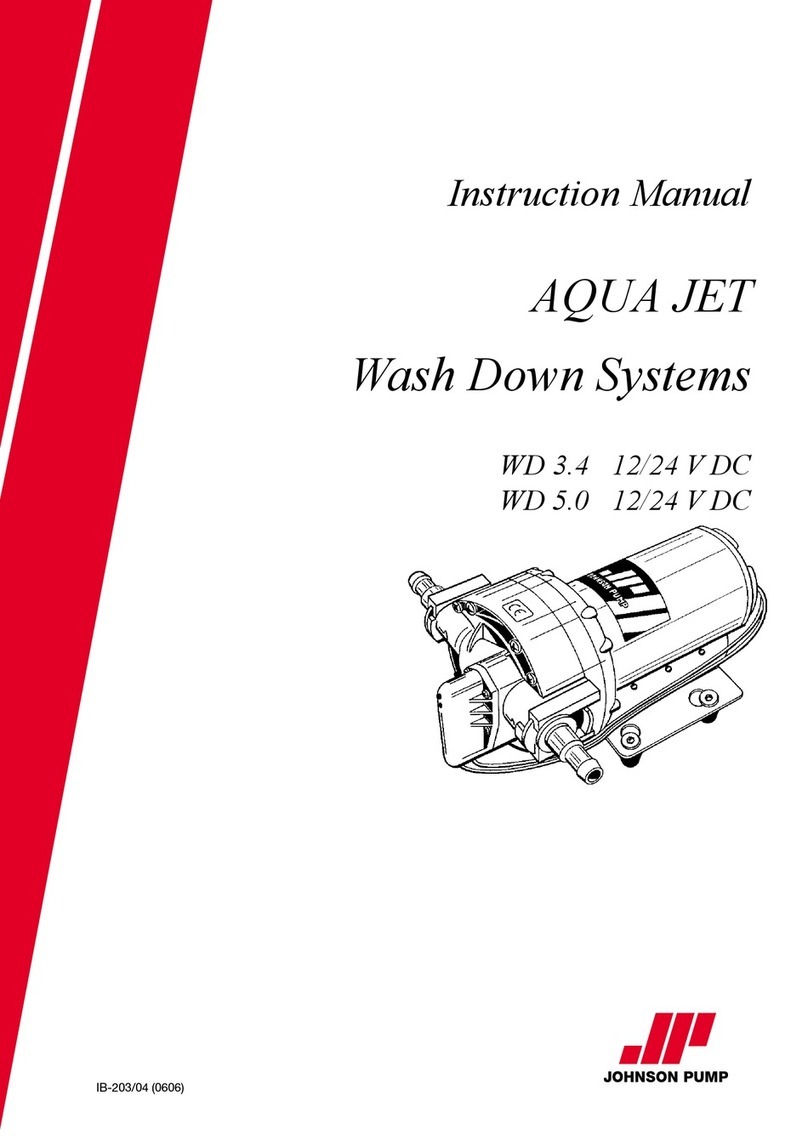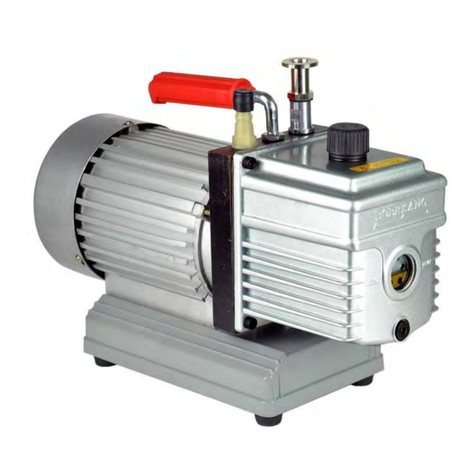Boulton Pumps ESK Series Installation instructions

ESK
Chemical Process
Centrifugal Pumps
Instructions for operation
and maintenance

Instructions for Installation, Operation and Maintenance.
Boulton pumps
All rights reserved. Can not be copied or reproduced for any purpose without permission.
07.2020
Revision 1

Content
1. GENERAL.......................................................................................................................................................................................................................................................................................3
1.1. IDENTIFICATION OF SAFETY AND WARNING SYMBOLS...............................................................................................................................................................................................3
1.2. GENERAL INSTRUCTIONS .................................................................................................................................................................................................................................................3
1.3. SAFETY INSTRUCTIONS .....................................................................................................................................................................................................................................................4
1.3.1. CE signs and approvals............................................................................................................................................................................................................................................4
1.3.2. Explosive atmosphere..............................................................................................................................................................................................................................................5
1.3.3. Monitoring..................................................................................................................................................................................................................................................................8
1.3.4. Constructional requirements ..................................................................................................................................................................................................................................8
1.3.5. Personnel qualification and training .....................................................................................................................................................................................................................8
1.4. RECYCLING..........................................................................................................................................................................................................................................................................8
2. ESK PUMPS ..................................................................................................................................................................................................................................................................................9
2.1. GENERAL .............................................................................................................................................................................................................................................................................9
2.1.1. Pump Description.....................................................................................................................................................................................................................................................9
2.1.2. Applications ...............................................................................................................................................................................................................................................................9
2.1.3. Pump Designation ....................................................................................................................................................................................................................................................9
2.1.4. Pump Nameplate .....................................................................................................................................................................................................................................................9
2.1.5. Technical Data ....................................................................................................................................................................................................................................................... 10
2.2. UNCRATING, TRANSPORT AND STORAGE................................................................................................................................................................................................................... 10
2.2.1. Uncrating................................................................................................................................................................................................................................................................. 10
2.2.2. Transport ................................................................................................................................................................................................................................................................. 10
2.2.3. Storage .................................................................................................................................................................................................................................................................... 11
2.3. INSTALLATION ON SITE .................................................................................................................................................................................................................................................. 11
2.3.1. Bare Shaft Pump ................................................................................................................................................................................................................................................... 11
2.3.2. Preparation for Installation.................................................................................................................................................................................................................................. 12
2.3.3. Installation Site ...................................................................................................................................................................................................................................................... 12
2.3.4. Coupling Alignment ............................................................................................................................................................................................................................................... 13
2.3.5. Connecting the Piping........................................................................................................................................................................................................................................... 14
2.4. START UP / SHUT DOWN ............................................................................................................................................................................................................................................... 18
2.4.1. Preparation............................................................................................................................................................................................................................................................. 18
2.4.2. Start Up the Pump................................................................................................................................................................................................................................................. 19
2.4.3. Shut Down the Pump ............................................................................................................................................................................................................................................ 19
2.4.4. Checks to be Made While The Pump is Running.............................................................................................................................................................................................. 19
2.5. LUBRICATION ................................................................................................................................................................................................................................................................... 20
2.5.1. Periods of Changing Oil ........................................................................................................................................................................................................................................ 20
2.6. DISASSEMBLY, REPAIR AND REASSEMBLY ............................................................................................................................................................................................................... 21
2.6.1. Disassembly ........................................................................................................................................................................................................................................................... 21
2.6.2. Reassembly ............................................................................................................................................................................................................................................................ 21
2.6.3. Shaft seal ................................................................................................................................................................................................................................................................ 22
2.7. SPARE PARTS .................................................................................................................................................................................................................................................................. 23
2.8. FAULTS, CAUSES and REMEDIES.................................................................................................................................................................................................................................. 23
2.9. TIGHTENING TORQUES ................................................................................................................................................................................................................................................... 25
2.10. EXPECTED NOISE VALUES ........................................................................................................................................................................................................................................... 25
2.11. PERMISSIBLE FORCES AND MOMENT AT THE PUMP FLANGES AND WEIGHTS ................................................................................................................................................ 26
2.12. PUMP DIMENSION GROUPS AND WEIGHTS............................................................................................................................................................................................................. 27
2.13. SECTIONAL DRAWINGS ............................................................................................................................................................................................................................................... 28

3
1. GENERAL
This manual is intended to be a reference guide for users of pumps providing information on:
Pump installation and maintenance instructions,
Pumps start-up, operation and shut - down procedures.
1.1. IDENTIFICATION OF SAFETY AND WARNING SYMBOLS
Safety instructions in this manual which could cause danger to life if not observed.
The presence of a dangerous electric current.
Non –observance to this warning could damage the machine or affect its functions.
Information to prevent explosion in the explosive atmosphere as per EC Directive 2014/34/UE (ATEX).
1.2. GENERAL INSTRUCTIONS
- This manual should be kept in a safe place and always be available to the qualified operating and
maintenance personnel responsible for the safe operation and maintenance of the pumps.
- Qualified personnel should be experienced and knowledgeable of safety standards.
- To avoid faulty operation and malfunctioning of pumps the instructions in this manual are to be carefully studied and
followed at all stages of the pump installation and operating life.
- The user is responsible for ensuring that authorized and qualified personnel who have studied this manual carefully
carry out inspection and installation.
- The pump should be used only in the operating conditions given on the order for which the pump and materials of the
construction have been selected and tested.
- If the pump is to be used for a different application please contact sales office or representative of the manufacturer.
BOULTON PUMPS refuses to assume any responsibility if the pump used for different applications without prior written
permission.
- If the pump is not to be installed and operated soon after arrival, it should be stored in a clean and dry place with
moderate changes in ambient temperature. Extreme low or high temperatures may severely damage the pump unless
suitable precautions are taken. The user is responsible for the verification of the ambient conditions where the pump will
be stored or installed.
- BOULTON PUMPS does not guarantee repairs or alterations done by user or other unauthorized personnel. The use of
original spare parts and accessories authorized by manufacturer will ensure safety.
- This manual does not take into account any site safety regulation, which may apply.

4
1.3. SAFETY INSTRUCTIONS
Strictly obey to the following instructions to prevent personal injuries and/or equipment damages:
- Pump should be used only in the specified operating conditions.
- Any weight, stress or strains on the piping system should not be transmitted to the pump.
- Electrical connections on the motor or accessories must always be carried out by authorized personnel and in
accordance to the local codes.
- Any work on the pump should be only carried out when the unit has been brought to standstill.
- Always disconnect the power to the motor and make sure not be switched on accidentally before working
on the pump or removing the pump from installation.
- Any work on the pump should be carried out by at least two persons.
- When approaching the pump always be properly dressed and/or wear safety equipment suitable for the work to be
done.
- Do not work on the pump when it is hot.
- Do not touch the pump or piping with temperatures higher than 80 ºC. User must take suitable precaution to warn the
persons (e.g. using warning signs, barrier).
- Always be careful when working on pumps that handling dangerous liquids (e.g. acids or hazardous fluids).
- Do not work on the pump when the pump and piping connected to the pump are under pressure.
- After completion of the work always fix the safety guards back in places previously removed.
- Do not run the pump in the wrong direction of rotation.
- Do not insert hands or fingers into the pump openings or holes.
- Do not step on the pump and/or piping connected to the pump.
1.3.1. CE signs and approvals
It is a legal requirement that machinery and equipment put into service within certain regions of the world shall conform
with the applicable CE Marking Directives covering Machinery and, where applicable, Low Voltage Equipment,
Electromagnetic Compatibility (EMC), Pressure Equipment Directive (PED) and Equipment for Potentially Explosive
Atmospheres (ATEX).
Where applicable, the Directives and any additional Approvals, cover important safety aspects relating to machinery and
equipment and the satisfactory provision of technical documents and safety instructions. Where applicable this
document incorporates information relevant to these Directives and Approvals. To confirm the Approvals applying and if
the product is CE marked, check the serial number plate markings and the Certification, see the last page of this
document.

5
1.3.2. Explosive atmosphere
This section should be read carefully for the pumps operating at explosive atmospheres.
Only the products certificated for the explosive atmospheres should be used at the explosive atmospheres.
Detailed information about the operating conditions at the explosive atmospheres are found in Directive on Equipment
for Potentially Explosive Atmospheres 2014/34/UE (ATEX).
The pumps to be used at the explosive atmospheres should never be used at areas apart from the specified areas.
1.3.2.1. Intended use - ATEX
The centrifugal pumps of the series ESN-EX or ESH-EX are Category 2 equipment according to the European Directive
2014/34/EU. They are designed to operate in Zone 1 (due to the presence of flammable gases or vapours of subgroups
IIIA and/or IIIB) and in Zone 21 (due to the presence of combustible dust of dust subgroups IIIA, IIIB and IIIC).
The assembly is suitable for operation with flammable liquids of sub-group IIA or IIB (ZONE 1).
The user must verify that the equipment purchased is suitable for operation in his facilities, according to the existing
zone classification and the characteristics of the products present.
The marking of these centrifugal pumps according to Directive 2014/34/EU is:
II 2GD Ex h IIB IIIC TX Gb Db X
or also
II 2G Ex h IIB T. Gb X
II 2D Ex h IIIC T…°C Db X
The "X" in the marking indicates "Special Conditions of Use":
1) It is a prerequisite for ensuring the safety of the equipment against the risk of explosion according to the requirements
of Category 2 that the centrifugal pump must at all times be operated in a primed condition with liquid inside. The user
who must ensure a sufficient liquid level to cover the impeller must observe this requirement.
2) The maximum surface temperature of the equipment depends on the pumped fluid:

6
Temperature class of the
centrifugal pump
Maximum surface
temperature
Maximum fluid temperature
T3
200ºC
180ºC
T4
135ºC
110ºC
Table 1
The user must check that the minimum ignition temperature of the flammable substances present or pumped is:
-For pumps marked T4: Higher than 135°C for flammable gases and vapours or temperature class T4, T3, T2 or
T1.
-For pump with T3 marking: Over 200°C for flammable gases and vapours or temperature class T3, T2 or T1.
For ESN-EX or ESH-EX pumps with marking for areas with combustible dust, the user must observe the following safety
margins, specified in EN 1127-1 and EN 60079-14, with regard to the minimum cloud (TMIN) and layer (TMIC) ignition
temperatures of the substances that may be present:
(2/3 × TMINube) ≥ Temperature marking in °C of the centrifugal pump.
(TMICapa - 75K) ≥ Temperature marking in °C of the centrifugal pump.
Therefore, the powdery substances present must have a self-ignition temperature:
-For pumps marked T4 or T135°C: greater than 203°C in a cloud and 210°C in a layer.
-For pumps with T3 or T200°C markings: over 300°C in a cloud and 270°C in a layer.
The manufacturer does not guarantee the safety of the ESN-EX or ESH-EX centrifugal pump against the risk of an
explosive atmosphere if the instructions given in this manual are not strictly observed.
1.3.2.2. Operation
The centrifugal pumps have been assessed and are ignition safe to operate in a zone classified as ZONE 1 and ZONE 2
for flammable gases/vapours (IIA and IIB) and as ZONE 21 and ZONE 22 for combustible dust (IIIA, IIIB and IIIC). Also to
operate with flammable liquids (IIA or IIB) indoors, under the conditions defined for ZONE 1 in internal parts. (*)
(*) The following definitions apply (Directive 1999/92/EC):
- "ZONE 1" as "working area in which an explosive atmosphere consisting of a mixture with air of flammable substances
in the form of gas, vapour or mist is likely to occur in normal operation occasionally".
- "ZONE 2" means a "place in which an explosive atmosphere consisting of a mixture with air of flammable substances
in the form of gas, vapour or mist is not likely to occur in normal operation but, if it does occur, will persist for a short
period only".
- "ZONE 21" as "working area in which an explosive atmosphere in the form of a cloud of combustible dust in air is likely
to occur occasionally in normal operation".
- “ZONE 22" as a "place of work in which an explosive atmosphere in the form of a cloud of combustible dust in air is not
likely to occur in normal operation or, if it does occur, will persist for a short period only".
Centrifugal pumps must always be primed, with liquid inside by submerging the impeller. The user must ensure this by
the method he considers most appropriate.
The user of the pump must ensure that the pump does not operate against a closed outlet
The pump must be installed and operated in a horizontal position.
In the case of pumps with oil-lubricated bearings, the oil level in the bearing housing must be visible through the built-in
sight glass.

7
The pump and its associated parts (motor, baseplate, pipes, etc.) must be equipotential and properly grounded.
1.3.2.3. Equipment with ATEX marking
The centrifugal pumps of the ESN-EX and ESH-EX series can be supplied with ATEX marked equipment from other
manufacturers (motor, flexible coupling, mechanical seal). The installed electrical and/or mechanical equipment, with a
given ATEX marking by third party manufacturers, must be checked and maintained according to the instructions given
by the manufacturers of such equipment and with the frequency indicated in their corresponding manuals.
Inspections and maintenance of ATEX electrical equipment that may affect its ignition protection (according to its ATEX
marking) must always be carried out in accordance with the EN 60079-17 standard.
The user must ensure that, after maintenance work, the installed electrical equipment has been connected in accordance
with the instructions of the equipment manufacturer and in conformity with EN 60079-14.
1.3.2.4. Equipotentiality and Grounding
All metal parts of the assembly are equipotential. The equipotentiality is guaranteed by means of metal braids joining
the different parts of the equipment or by means of the metal-metal joint. The equipotential connections must be
checked periodically.
Special attention should be paid to the equipotential connection of the metal parts of the assembly, especially after
maintenance work involving the disassembly of parts of the assembly. After such maintenance, the metal braids of the
equipotential connection must be reconnected and it must be checked that there are no isolated metal parts.
The whole assembly must be properly grounded.
The user must ensure proper grounding of the installations. This grounding must be periodically checked as established
in the Low Voltage Electrotechnical Regulations or equivalent national legislation.
1.3.2.5. Chemical compatibility
The user must ensure that the chemicals (gaseous or solid) that are or may be present in his premises are compatible
with the construction materials of the pneumatic conveying system. These substances must not cause corrosion,
exothermic reactions or physic-chemical alterations to the parts and components of the assembly (metal or non-metal
parts, internal or external).
1.3.2.6. Lubricants
The lubricants used in the conveyor system must be chemically compatible and not generate exothermic reactions with
the products that are or may be present inside the conveyor system or at its location.
These lubricants must have an ignition temperature of at least 185°C (for T4 pumps) or 250°C (for T3 pumps), which is
50K higher than the maximum surface temperature marked for the equipment.
1.3.2.7. Maintenance
The correct tightness of the pump parts and bolted elements must be checked periodically.
Special attention should be paid to the moving parts of such equipment: air gaps, seal bearings, shaft alignment, etc.
Periodic checks should be made of:
-Condition of the bearings in order to detect possible wear or premature failure and to replace them if necessary.
Special attention should be paid to signs such as abnormal noise, difficult rotation, loss of lubricant,
discoloration, etc.
-Condition of seals, seals, etc., checking that they maintain protection against the entry of solid or liquid elements
into the shafts.
-Correct alignment of shafts, verifying the absence of signs of friction between metallic elements.

8
1.3.2.8. Cleaning
Periodic cleaning of the external parts of the equipment should be carried out to prevent the accumulation of dust
deposits, in particular in the vicinity of moving parts. Accumulations of dust thicker than 5mm should be avoided.
1.3.3. Monitoring
Pump and/or pumpset should be operated according to duty point and the limit described in nameplate.
The technical personnel should operate the pump within these limits and the status monitoring system
should be used for the pump set.
Use of the monitoring system is important especially for the following areas of the pump:
Temperature values on the pump casing.
Temperature values in the sealing area.
In the systems where buffer liquid is supplied or double mechanical seal is available the buffer liquid should be observed.
Temperature values in the bearing area.
For proper operation of the bearings, it would also be useful to monitor vibration and temperature values in the roller
bearing.
The pump should be operated according to ordered duty point.
1.3.4. Constructional requirements
When explosive fluid is pumped, all parts under pressure should be made of ductile material.
Coupling protection housings should be made of non-sparking materials.
Mechanical seals should never be operated dry. The sealing area should be filled with liquid completely as long as the
pump operates. If you are not sure that the sealing area is filled with liquid, then the buffer liquid may be applied.
Frame of the pump and/or pump set should always be earthed.
1.3.5. Personnel qualification and training
All personnel involved in the operation, installation, inspection and maintenance of the unit must be qualified to carry
out the work involved. If the personnel in question do not already possess the necessary knowledge and skill, appropriate
training and instruction must be provided. If required the operator may commission the manufacturer / supplier to
provide applicable training.
Always co-ordinate repair activity with operations and health and safety personnel, and follow all plant safety
requirements and applicable safety and health laws and regulations.
1.4. RECYCLING
For products and arts, which will not be used and scraped, use the local or private waste collection services. If it is not
possible, consult the nearest authorized service centre of Boulton Pumps.

9
ESK PUMPS
2.1. GENERAL
2.1.1. Pump Description
ESK series pumps are horizontal, radially split volute casing, single stage, end suction centrifugal pumps with closed or
semi-open impeller.
Dimensionally complies with EN 22858 / ISO 2858.
2.1.2. Applications
ESK series pumps are suitable for clean or slightly contaminated (max. 20 mg/dm³) liquids with low viscosities and
temperatures up to 175 ºC. The main application areas, among others, are:
Chemical and Petrochemical Industry.
Food and Beverage Industry
Refineries and Loading Plants.
Cooling and Heating Plants
Paper and Cellulose Industry.
Water Treatment Plants.
Iron and Steel Industry.
Power Plants.
2.1.3. Pump Designation
ESK X -150 –250
Pump Type
Impeller type
Discharge nozzle (DN in mm)
Nominal impeller diameter (mm)
2.1.4. Pump Nameplate
- TP: Pump Type and Size
- Y: Production Year
- No: Serial Number
- Q: Capacity
- H: Head
- P: motor Power
- n: Speed
- Ø: Impeller Diameter
- Direction of Rotation

10
2.1.5. Technical Data
Speed : up to 3600 rpm
Discharge Nozzle : DN 32 up to 250 mm
Suction and Discharge Flanges : DIN 2532 / PN16
Operating Temperature : -10º C up to 175º C
Ambient Temperature (max) : 40º C
Casing Pressure (max) : 16 bar (25 bar*)
2.2. UNCRATING, TRANSPORT AND STORAGE
2.2.1. Uncrating
Upon receipt, verify that the goods received are in exact compliance with that listed on the packing list.
Check that no visible damage exists on the crate that could have occurred during transportation.
Carefully remove the packaging material and check that pump and accessories (if any) are free from any markings,
stretches and damages, which may have occurred during transportation.
In the event of damage, report this immediately to BOULTON PUMPS service department and to the transport
company.
2.2.2. Transport
2.2.2.1. General recommendations
- Existing regulations for the prevention of accidents must be followed.
- Wearing of gloves, hard-toed boots and hard hats is obligatory for all transport works.
- Wooden cases, crates, pallets or boxes may be unloaded with fork-lift trucks or using hoisting slings, depending on their
size, weight and construction.
2.2.2.2. Lifting
Prior to lifting and moving the pump or pump and motor on a common base plate find out the following:
- Total weight and center of gravity.
- Maximum outside dimensions.
- Lifting points location.
The load-bearing capacity must be proper to the weight of the pump or the pump set.
The pump or pump set must always be raised and transported in horizontal position.
It is absolutely forbidden to stand beneath or nearby a raised load.
A load should never remain in a raised position for longer than necessary.
Accelerating and braking during the lifting process must be performed such that there is no danger to persons.
When lifting the pump or complete pump set lift them as shown in Fig.1a and Fig.1b respectively to avoid any distortion
(especially do not use the motor eyebolt for carrying the complete unit).

11
Fig. 1a. Bare shaft pump Fig. 1b. Pump and motor over a baseplate
2.2.3. Storage
If the pump is not to be installed and operated soon after arrival, store the pump in a clean, dry and frost-free place
with moderate changes in ambient temperature.
If the pump has regreaseable bearings, pump extra grease on bearings to prevent moisture from entering around
the shaft.
To prevent the pump from moisture, dust, dirt and foreign materials suitable steps should be taken.
The pump shaft should be revolved periodically (e.g. once a week) to prevent pitting of the bearing surfaces and the
pump from seizing up.
2.3. INSTALLATION ON SITE
Installation has to be carried out in accordance with EN 60204-1.
The pump should only be installed, levelled up and aligned by skilled personnel. Incorrect installation or defective
foundation could result in troubles. This would not be covered by the warranty.
2.3.1. Bare Shaft Pump
If the pump has been supplied with bare shaft end it is required to prepare a proper base plate on which to mount
the pump and motor assembly. The base plate must be properly designed and manufactured for enough rigidity to
prevent vibrations and distortions.
If the pump has been supplied without electric motor and coupling it is necessary to select a proper motor and
coupling before proceeding to the installation of the unit.
The following considerations must be taken into account for selection of motor:
- Maximum power absorbed by the pump over the total operating range.
- Pump operating speed.
- Available power (frequency, voltage, etc.).
- Motor type (TEFC, exproof, etc.).

12
- Motor mounting position (foot mounted, flange mounted, horizontal, vertical, etc.).
When selecting the coupling, nominal motor power and operating speed must be taken into account.
2.3.2. Preparation for Installation
Before installing the pump:
Clean the suction and discharge flanges thoroughly.
Remove the protective coating from the pump shaft.
If the pump has been in temporary storage remove all the grease from the bearings with grease lubricated or remove
the oil from the bearing house if the pump is oil-lubricated, then clean the bearings with a suitable cleaning fluid and
relubricate (NOTE: This is not necessary for the pumps with life time grease lubricated bearings).
2.3.3. Installation Site
The pump must be installed in a frost and dust-free, well-ventilated and non-explosive environment.
The pump should be installed such that there is space for access, ventilation, maintenance and there is sufficient
space above the pump for it to be lifted.
The suction pipe should be kept as short as possible.
2.3.3.1. Foundation
The greatest care must be taken in preparing the foundation and mounting the pump set. Incorrect
installation will result in premature wear of pump components and break down of the pump.
The foundation should be heavy enough to reduce vibrations and rigid enough to avoid any twisting or misalignment.
Make sure the concrete foundation has set firm and solid before mounting the pumpset. The surface of the foundation
should be truly horizontal and perfectly flat.
2.3.3.2. Installation
Place the pumpset on the concrete and by adding or removing shims under the baseplate align the discharge flange
horizontally by using a sprit level on it as shown on Fig.2. Make sure it is completely horizontal.
Slightly tighten the anchor bolts.
Check the coupling alignment as explained in section 2.3.4.
Fig. 2. Foundation, baseplate and fitting the shims

13
2.3.4. Coupling Alignment
For a trouble free service life of the pumping unit the
most important factor is aligning the coupling properly.
The main reason for vibration, noisy operation, warming bearings and
overloading is an unaligned or misaligned coupling. Therefore the coupling
should be correctly aligned and be checked frequently.
A flexible coupling should never be expected to correct misalignment. A
FLEXIBLE COUPLING IS NOT A CURE FOR MISALIGNMENT AT ALL AND IT
DOES NOT COMPENSATE FOR EXCESSIVE MISALIGNMENT. A flexible
coupling will only compensate for small amount of misalignment.
“Coupling Alignment” means to secure the motor and
pump rotation axes on the same straight line. ESK series
pumps are dispatched from our factory after the coupling alignment is
precisely secured if supplied with driver and baseplate. A certain amount of
deformation of the baseplate is possible during handling and transit. For this
reason, regardless of the excellent alignment made at factory, THE PUMP
AND DRIVER HAVE TO BE REALIGNED DURING INSTALLATION.
Two pieces of minimum 100 mm long metal stripes with straight edge
(steel ruler) and a precise calliper are needed to align the coupling
(special instruments must be used for a very fine and precise
alignment).
There may be two forms of errors for coupling alignment:
a) Angular error.
b) Parallel sliding error.
To check the angular error, the gap between the coupling halves must
be the same at all points horizontally and vertically.
To control parallel sliding error, straight edged steel ruler is pressed
down on one half of the coupling in parallel to the axis. It is checked
against the other half. Straight edge must touch to the both half
couplings completely same at all points in each vertical and horizontal
planes (Fig.3).
Alignment errors can be either on vertical plane or horizontal plane. On
vertical plane alignment is corrected by inserting shims under the pump
or motor foot, and on horizontal plane alignment is corrected by sliding
the pump and/or motor horizontally sideways by using the gaps at
mounting holes. Fig. 4a, 4b, 4c, 4d show alignment of coupling step by
step.
Following any alternation, each alignment should be
rechecked because any movement due to an adjustment
in one direction may cause misalignment in another.
Fig. 3. Aligning a flexible coupling
Fig. 4a. Angle error in horizontal plane and to settle
Fig. 4b.Angle error in vertical plane and to settle
Fig. 4c. Parallel sliding error in horizontal plane and to
settle
Fig. 4d. Parallel sliding error in vertical plane and to settle

14
2.3.5. Connecting the Piping
2.3.5.1. General
Never use the pump as an anchorage point or as a carrier for the piping.
The pipes should be supported very near the pump (Fig. 5). It must be checked that any weight, stress or strains on
the piping system should not be transmitted to the pump. Therefore after completing the piping installation, the bolt
and connection on the suction and discharge nozzles must be loosened to ensure that there is not any stress on the
piping system to the pump.
The nominal sizes of the pump suction and discharge nozzles are no guide to the corrects sizes of the suction and
discharge piping. The nominal bores of the pipes should be same as or greater than those of the pump nozzles. Never
use pipes or accessories which have smaller bore than the pump nozzles. Particularly foot valves, strainers, filters
and non return valves must be preferred with larger free transition areas. In general the flow velocities should not
exceed 2 m/s in the suction piping and 3 m/s in the discharge piping. Higher flow velocities will result in higher
pressure drops, which could cause cavitation conditions in the suction piping and excessive friction losses in the
discharge piping.
Pipe joints should be by means of flanges with flange gaskets of proper size and material. Flange gasket must be
centered between the flange bolts in a such way that there is no interference with the flow of the liquid.
Thermal expansions of the pipework and excessive vibrations should be accommodated by suitable means so as not
to impose any extra load on the pump.
Prevent impurities such as welding beads, scale, sand and tow might be left in pipes while production of the piping
system harms the pump. Seal the pump nozzles by means of blind gasket to stop impurities get in the pump. After
assembling the system all the piping parts must be disassembled, thoroughly cleaned, painted and reassembled
again. If a strainer is used on the suction side of the pump, it must be cleaned after several days of operation.
2.3.5.2. Suction piping (Fig. 5, 6)
The suction piping must be absolutely leak-tight and not present any features likely to promote the formation of air
pockets. Suction piping therefore should have a slight downward slope towards the pump in the case of suction head
installation (e.g. flooded suction) and slight upward slope towards the pump in the case of suction lift installation.
In order to keep the pipe friction losses as low as possible it is essential to avoid any sharp bends and abrupt changes
of direction or cross-section and the suction pipe should be kept as short as possible. If it is necessary to change the
cross-section of a piping laid almost horizontal, an eccentric reducer, with top horizontal, should be used.
A positive suction head piping should incorporate an isolating valve with the valve stem in the horizontal position.
This valve should always remain fully open while the pump is running and must not be used to regulate the flow.
Fig. 5a. Suction Lift
Fig. 5b. Suction Head

15
2.3.5.3. Discharge piping (Fig. 6)
A control valve should be installed in the discharge pipe, as close to the pump as possible, to regulate the required
flow and head.
If the total head of the pump exceeds 10 meters or if discharge line is of appreciable length a non return valve should
be installed between the pump and isolating valve on the discharge line to protect the pump against water hammer
and reverse flow on shut down.
Fig. 6a. Suction Lift Fig. 6b. Suction Head
2.3.5.4. Auxiliary Connections
Depending on the application auxiliary pipe connection (drainage etc. necessary for
the pumping system) and/or accessories to check the operating conditions (pressure
gages, temperature gages etc.) may be made up and laid.
Pressure and vacuum gauges must be properly anchored and connected at the
measuring points located on the pipes approximately 2D close to the flanges
with approximately 8 mm diameter tubing with pig tail configuration to lessen
pressure fluctuation. For safety purposes isolating and vent valves should be
fitter before the gauges (Fig. 7).
Every pump is fitted with connection on the pump casing to drain the pump (Fig.
8). If required the pump drain can be piped to a suitable reservoir. The pump
draining piping must be fitted with an isolating valve and both must be suitable
for the maximum operating pressure of the pump.
Cooling, sealing and flushing of seal piping must be connected only to the
designated connections located on the pump (See Fig. 8 to 12).
Fig.7

16
d1 : Pressure gauge (discharge).
d2 : Pressure gauge (suction).
d3 : Filling or vent.
d4 : Drain.
d5 : Oil filling.
d6 : Oil drain.
d7 : Oil sight gauge.
d8 : Seal leakage drain.
S1 : Seal flushing liquid inlet from external source.
e1: Double mechanical seal buffer liquid inlet from external source.
e2: Double mechanical seal liquid outlet.
e3: Single mechanical seal flushing liquid inlet from external source.
e4: Single mechanical seal flushing outlet.
C1: Stuffing box cooling liquid inlet.
C2: Stuffing box cooling liquid outlet.
Fig.8
Fig.9
Fig.10a
Fig.10b
Fig.11

17
2.3.5.6. Electrical Connections
The electrical motors have to be built in accordance with EN 60034-1.
Enclosures of electrical motors and control systems on the pump unit shall as a minimum give protection
in accordance with EN 60529 IP22. But in determining the degree of protection of enclosures of electrical
motors and control systems on the pump unit the operating and environmental conditions must be taken into
consideration.
Electrical connection should be done by a qualified electrician. Current national regulation and motor manufacturer’s
instructions must be observed.
Take all safety precautions listed in “Safety Instructions”. Disconnect all power supplies prior to doing any work.
The supply cable must be laid in such a way that it never touches the pipework, pump and motor casing.
Check voltage, phase and frequency on motor nameplate with the mains.
The electric motor must be protected against overloading by means of circuit breakers and/or fuses. Circuit breakers
and fuses must be selected in accordance with full load amperage of the motor appearing on the motor rating plate.
It is recommended to use PTC (Passive Thermal Control) on motor, but this is optional depending on customer
requirement. In case of using PTC, these should be connected via corresponding terminals in the terminal box and
the PTC should be connected to the thermal trip mechanism.
Prior to connecting the electrical wiring rotate the pump shaft by hand to make sure rotor rotates easily.
Connect the electrical wiring in accordance with local electrical codes and make sure to ground the motor.
The connection diagram can be found in the terminal box of the motor or in the instruction manual.
The mains connection on the tagboard depends on the nominal power of the motor, the power supply and the type
of connection. The necessary connection of the bridges in the terminal box is shown in the following (Table 1. and
Fig. 12a, 12b, 12c).
Type of switch
Motor Power
𝑃𝑁≤ 4 𝑘𝑊
Motor Power
𝑃𝑁> 4 𝑘𝑊
Power supply
3 ≈ 400 V
Power supply
3 ≈ 400 V
Direct
Y –connection (10b)
∆- connection (10a)
Y / ∆ - start
Impossible
Remove connecting
Bridges (10c)
Table 2
Fig. 12a.∆- connection
Fig. 12b. Y –connection
Fig. 12c. Y / ∆ connection

18
In the case of three-phase induction motors with Y / ∆–connection it must be ensured that the change-
over points between star and delta follow on from one another very quickly. Longer change-over times
may result in pump damage (Table 2).
Motor Power
Y –set time
≤ 30 kW
> 30 kW
< 3 sec
> 5 sec
Table 3
2.3.5.7. Final check
After completion all the above process check the coupling alignment once more as described in 2.3.4. Correct if there is
a fault. Rotate the pump rotor several times by hand. Make sure rotor rotates easily. Fix the safety guards in places then
run the unit until it warms up and normal operating conditions are reached. Now shut it down and make final alignment
by shimming driver only. Final alignment should be made at operating temperature.
Fix the coupling guard back in place. Do not operate the pump before doing so. This is a necessity for security
and job safety.
2.4. START UP / SHUT DOWN
2.4.1. Preparation
2.4.1.1. Lubrication Control
Grease lubricated bearings are factory packed with grease enough for one year operation before dispatch. Before
initial start up the pump it should be ascertained that no dirt has penetrated inside the bearing during transport or
installation on site. Otherwise, the bearings should be cleaned out and repacked with fresh grease before start up.
If the pump is stored for a long time before installation (more than 6 months) pump extra grease on bearings.
Oil lubricated pumps are dispatched without oil and this is indicated with a warning label. Fill the bearings housing
of this kind of pump with oil until the marked level on the gauge.
See 2.5. for lubricating.
2.4.1.2. Check the shaft seal (see 2.6.3)
2.4.1.3. Venting and Priming
Make sure that the pump and suction pipes are completely filled up with water. There is no problem for the pumps
which have positive suction head. If there is a valve on suction line, it must be opened and air taps are loosened to
enable the water replaces air in the pump, until it is completely full with water.
If there is a foot valve for the pump, which has suction lift, pump is filled up with water through the filling tap at the
highest point of the pump and the air is emptied out.
If the system has a vacuum pump, water is brought up in the rising pipe and filled up the pump through this vacuum
pump. When water is risen up to the highest point then the pump is started up.
Make sure the pump never runs dry.

19
2.4.1.4. Checking the direction of rotation
ESK type pumps rotate in clockwise when it is looked from coupling to the pump. This direction is already indicated on
the pump nameplate by an arrow. Check this by switching the pump on, then off again immediately. Fit the coupling
guard back in place if you took it out.
2.4.2. Start Up the Pump
Check if the shut off valve in the suction line is open and the shut off valve in discharge line is closed.
Switch on the circuit breaker and run the motor.
Wait until the motor reaches the full speed (on star-delta running motors wait until it switches on delta).
Open the discharge valve slowly while watching the ampermeter on the control panel (if the discharge line is empty
do not turn on the valve fully open on first start up. Turn it on slowly to maintain the value on the ampermeter is
under the rated current value of the motor).
When the valve is if fully open, check the pressure on the manometer and see it is the same with the duty point
pressure. If the pressure on the pressure gauge is lower than duty point pressure brings them to the duty point value
by slightly closing the valve. If it is higher value, check your installation, particularly head again.
The pump should be shut down at once and the trouble should be corrected if the pump is running at
it rated speed and found any of the following faults:
-Pump doesn’t deliver any liquid.
-Pump doesn’t deliver enough liquid.
-Flow is going down.
-Discharge pressure is not enough.
-Driver overloaded.
-Vibration on pump.
-High noise level.
-Bearing overheating.
2.4.3. Shut Down the Pump
Slowly close the shut-off valve in the discharge line.
You may shut down the pump without closing the shut-off valve if there is a device for water hammer protection on
the discharge line or the water hammer is not a considerable level.
Switch off the driver. Ensure the pump set runs down smoothly and quietly to a standstill.
Shut off external sealing liquid supply, if supplied, to relieve stuffing box pressure.
If the set is to remain out of services for a long time close the shut-off valve in the suction pipe. Close off the auxiliary
connections. In the event of frost and/or prolonged standstill, drain the pump or otherwise protect against freezing.
2.4.4. Checks to be Made While The Pump is Running
The pump must run smoothly, quietly and free from vibration at all times.
The pump must never run dry.
Never run the pump for along period against a closed discharge valve (at zero flow).
The bearing temperature may exceed the ambient temperature by up to 50º C. But must never rise above 80º C.
The valves in the auxiliary lines must remain open while the pump is running.
Table of contents
Popular Water Pump manuals by other brands
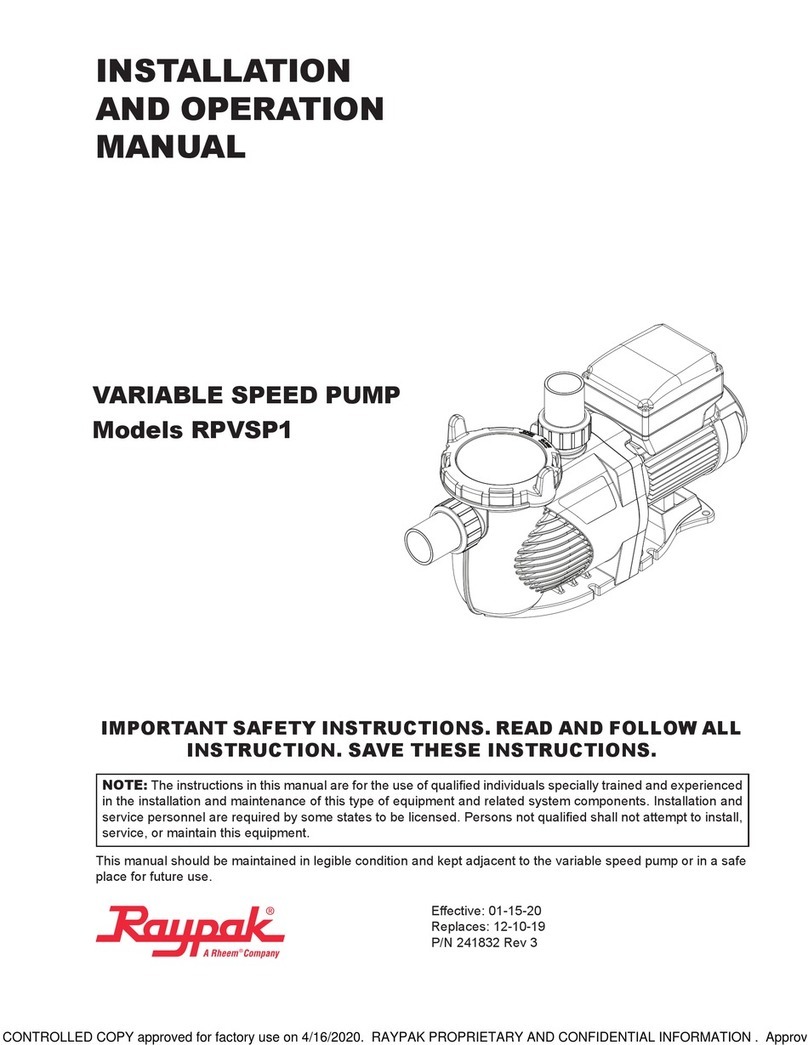
Rheem
Rheem Raypak RPVSP1 Installation and operation manual
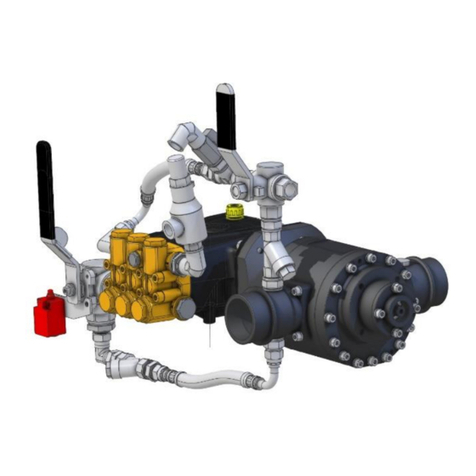
Firemiks
Firemiks 450-3-PP-F-ALU-FM instruction manual
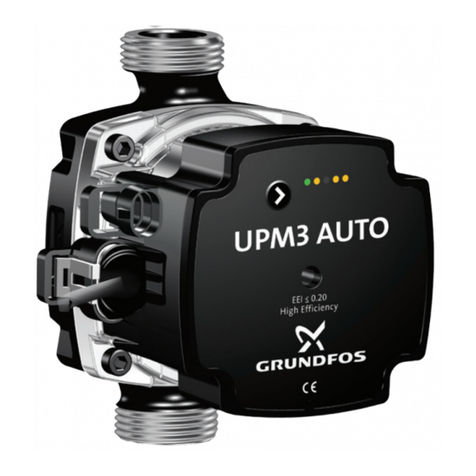
Grundfos
Grundfos UPM3 instructions
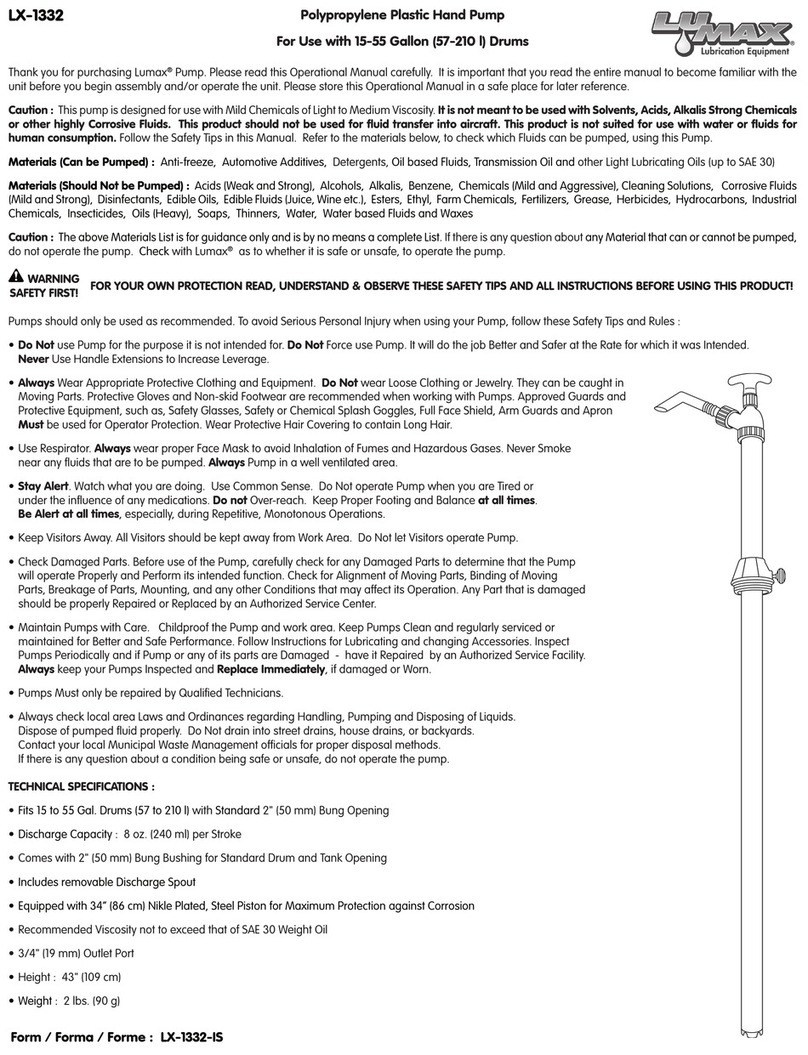
Lumax
Lumax LX-1332 quick start guide
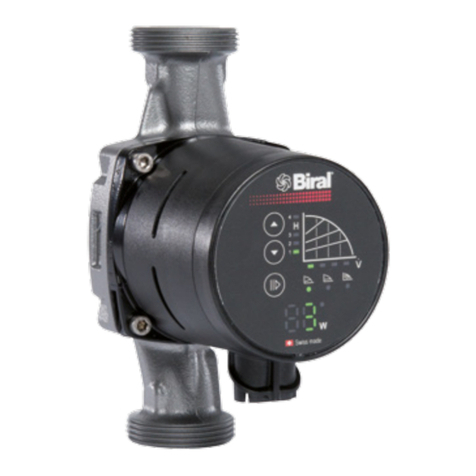
Biral
Biral PrimAX RED Series Installation and operating instructions

Wayne
Wayne CDT50 Operating instructions and parts manual

